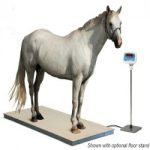If you frequent our learning center aka blog then you are probably familiar with our DIY video reviews that we like to do from time to time. Today’s entry is fairly short but it covers a real world problem especially for customers who may be in locations like Alaska or Hawaii.
As you can see from the video the scale owner is frustrated because it costs a lot of money to ship a decent size scale from the continental United States to Alaska. I can also tell you that is absolutely true. Shipping costs in general are getting higher but it really costs a lot to ship to AK.
Save on Scale Freight Costs to AK
So, one way to get around having to pay so much in freight costs is to build your own scale using a livestock scale kit like we offer. These kits are great because they include all the components that you need to build a scale. They even include things like the mounting plates and the bolts. And all of these components are offered at a great price. Sure you could hunt around and buy each piece individually but I doubt that you’d save any money by doing that. Just buy the kit and get to building (and weighing).
The real key to this strategy is to understand how to build a good quality scale platform. When I watch the video it appears the scale user is doing just that. He has a solid outer frame that he has built and he has added some angle iron to help support the wooden top deck. I’m usually not a fan of the wood deck due to flexing, but in this case I think it will work fairly well with the sides and the support pieces.
The person narrating the video doesn’t show us the weight indicator so I can’t say much about that. He shows a shear beam load cell but they haven’t been mounted yet. Of course, if you’re going to mount the load cells, you want to put one in each corner of the scale platform. You also want to make sure that you place the load cell mount in-between the scale platform and the load cell. This will help to secure the loadcell and it gives you the gap that you need for the load cell to slightly bend and be able to work properly.
Platform Scale Construction Tips
Now one other point that I always like to mention is the junction box with summing board. I would recommend during your construction phase, to add a small pocket in your platform to place the junction box. In case you don’t know, the basic layout of a platform scale is that you want to take the (4) cables from your load cells and run those to your junction box. You need to do that safely so they don’t get damaged either during construction or later on during daily use. Then all those cables will be connected to your summing board which is inside the junction box. Then, a homerun cable runs from the junction box to your digital weight indicator. Bonus Tip: You want to make sure the junction box can be accessed from the top side of the scale platform. This will make adjusting and/or troubleshooting your new scale much easier!

For the actual setup and calibration ideally you will have some type of heavy object that you know the weight of. This needs to be fairly precise because this is what you’re using to calibrate the scale. You’ll want to walk the four corners of the scale platform and adjust the scale foot on each corner to make sure it is level and not rocking back and forth. You also may need to adjust the corners on your summing board if they’re a little off.
Overall I like what this person did with his scale in our DIY Video – Build Your Own Platform Scale entry. It looks like he built a pretty good quality scale and probably saved thousands of dollars between the scale manufacturer and the freight companies.